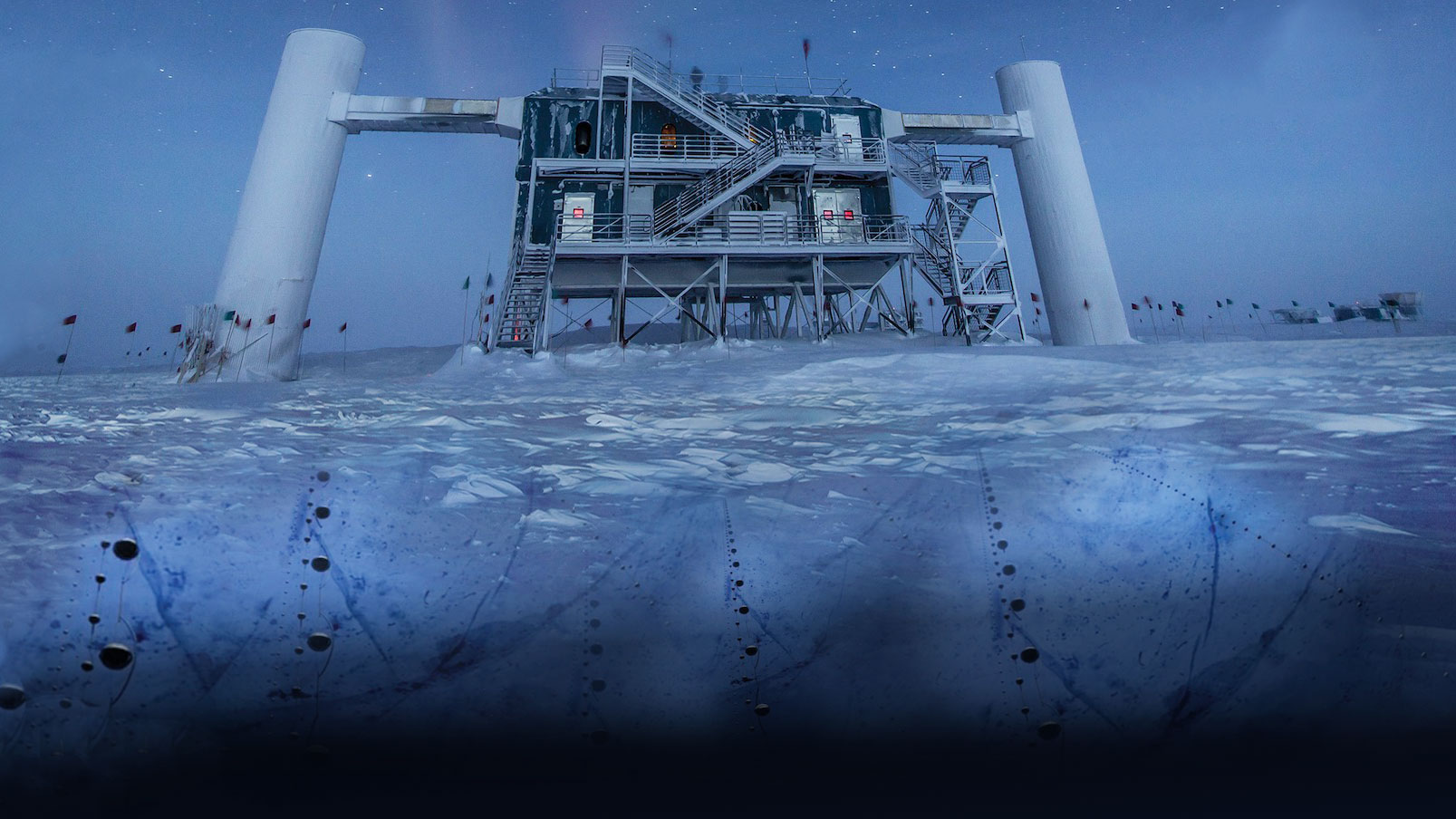INTERNATIONAL CENTER FOR HADRON ASTROPHYSICS
REVEALING HIDDEN MESSAGES FROM THE COSMOS
-From a remarkable observatory buried deep
in the south polar ice, Chiba University astrophysicists are helping to explore the origins of the Universe.
Research Keywords:Neutrino Astronomy, Cosmic Rays, South Pole, Elementary Particle Experiment

Humans have been observing the stars for tens of thousands of years, first with our eyes, then with optical telescopes, and more recently using devices that can detect light at the extremes of the electromagnetic spectrum far beyond the visible range. Yet despite phenomenal progress in astronomy over the past half century, much of the Universe remains completely hidden from view, obscured by other matter, other radiation sources, and light’s interaction with the interstellar medium.
Now, scientists are on the verge of being able to peer into some of the most mysterious corners of the cosmos using not light but neutrinos — near-massless subatomic particles that travel close to the speed of light across the Universe without being deflected by magnetic fields or absorbed by matter.
The International Center for Hadron Astrophysics (ICEHAP) led by Shigeru Yoshida is part of the global collaboration responsible for managing the IceCube Neutrino Observatory deep in the ice at the South Pole’s Amundsen–Scott station.
“One of the longest standing puzzles in astrophysics is the origin of high-energy cosmic rays and neutrinos,” says Yoshida. “The new windows to our Universe opened by neutrino observations, combined with powerful computer simulations of cosmic plasma, have great potential to finally resolve this mystery.”
THE ICECUBE COLLABORATION
Neutrinos are the most abundant particles in the Universe after photons (light particles). They originate in some of the most violent and least understood cosmological phenomena like supernovas, galactic cores and black holes. After their birth, they travel in straight lines from their source with almost no deflection or absorption, making them ideal messengers from the heart of these mysterious astronomical objects. But these same properties also make them exceedingly difficult to detect.
The IceCube collaboration, involving 300 physicists from 48 institutions in 12 countries, has gone to extreme lengths to detect these ghost-like, high-energy particles. The IceCube observatory is a cubic kilometer of crystal-clear ice, deep below South Pole Station — the only place on Earth where such large volumes of clear, pure and stable ice can be found along with the infrastructure needed to support scientific research. By suspending thousands of delicate photodetectors on strings in a network of vertical holes drilled through the ice, physicists can capture the rare explosion of energy that occurs when a neutrino collides with an oxygen or hydrogen nucleus.
Of the trillion, trillion neutrinos that pass through IceCube every day, the facility records just a few hundred collisions from high-energy neutrinos — a minute fraction of the neutrino flux but more than enough to stimulate some very exciting research. “We are proud of having been key players in the discovery of high-energy cosmic neutrinos, which astrophysicists have been dreaming about for more than 30 years,” says Yoshida talking about his team members in ICEHAP.
Another important contribution of ICE- HAP to understanding the high-energy Universe is its supercomputer-based mas- sive numerical simulation program for deep investigation of the physical mech- anisms behind high neutrino production. “Through our simulations we are helping to uncover the hidden messages carried by these neutrinos and to reveal the physical mechanism by which high-energy cosmic rays are accelerated at their source,” says Yoshida.
In 2018, the IceCube collaboration has finally discovered that a special type of galaxy, TXS 0506+056, is a birthplace of cosmic neutrinos. This achievement was selected as one of the top break- throughs by Science. In 2022, the team’s new detectors called “D-Egg” will be used at the South Pole. It clearly shows the steps being taken forward.It clearly shows the steps being taken forward.
(CHIBA RESEARCH 2020)Members
Principal Investigator
| Name | Title, Affiliation | Research Themes |
|---|---|---|
| YOSHIDA Shigeru | Professor, Graduate School of Science / ICEHAP |
Neutrino Astronomy |
Co-Investigatior
| Name | Title, Affiliation | Research Themes |
|---|---|---|
| ISHIHARA Aya | Professor, IGPR / ICEHAP | Neutrino Astronomy |
| NAGAI Ryo | Specially Appointed Assistant Professor, IGPR / Graduate School of Science / ICEHAP | Neutrino Astronomy |
| MATSUMOTO Ryoji | Professor, Graduate School of Science / ICEHAP | Astronomy |
| MATSUMOTO Yosuke | Specially Appointed Associate Professor, Graduate School of Physics Science / ICEHAP | Cosmic Plasma Physics |
| HANAWA Tomoyuki | Professor, Center for Frontier Science / ICEHAP | Astrophysics |
| ISHIYAMA Tomoaki | Associate Professor, IMIT / ICEHAP |
Numerical Astrophysics |
| HOTTA Hideyuki | Associate Professor, Graduate School of Science / ICEHAP | Cosmic Plasma Physics |
| KIN Kenichi | Research Fellow, Graduate School of Science / ICEHAP | Neutrino Astronomy |
Related links
Press Release
| July 16, 2019 | NSF mid-scale award sets off the first extension of IceCube The IceCube Upgrade: An international effort |
